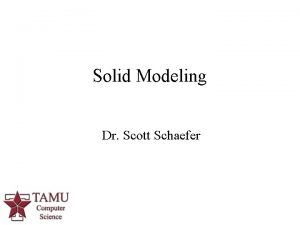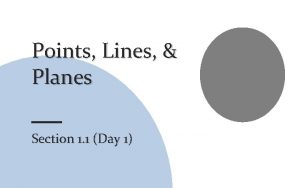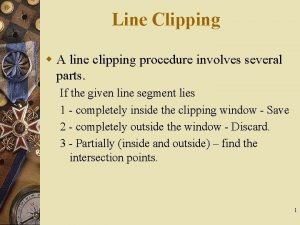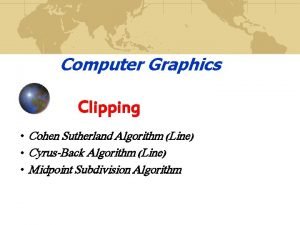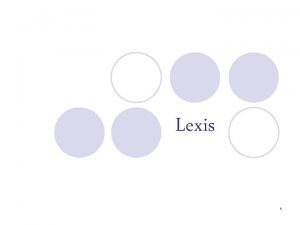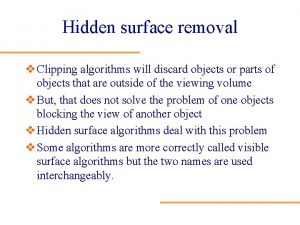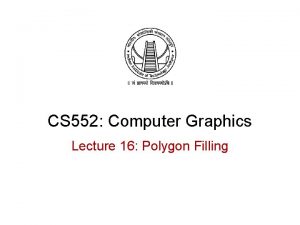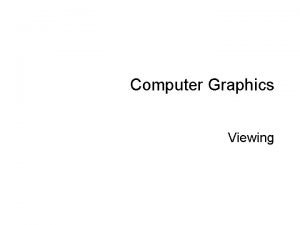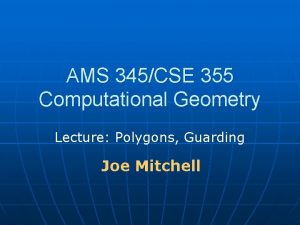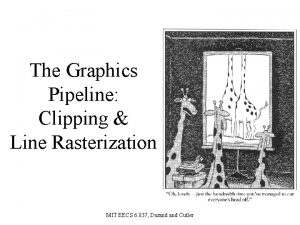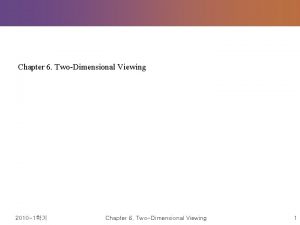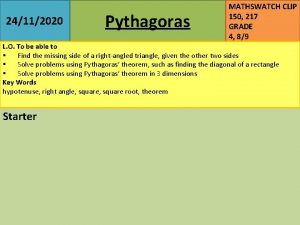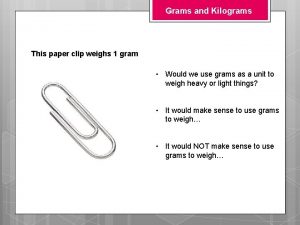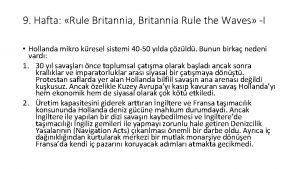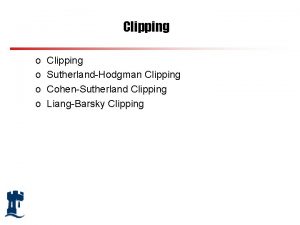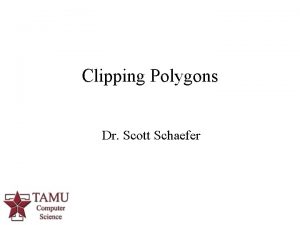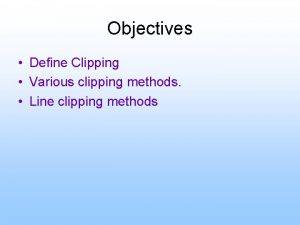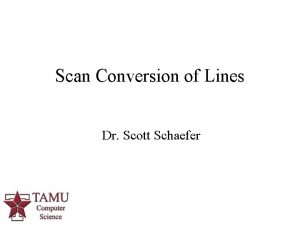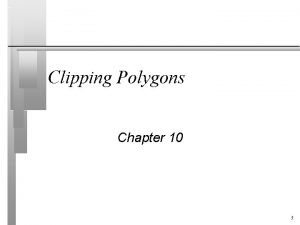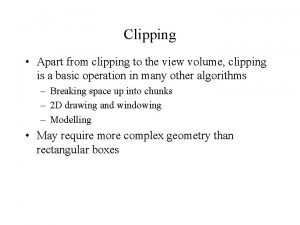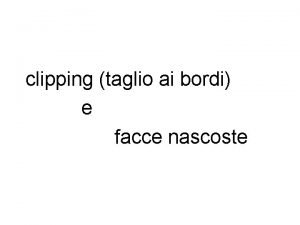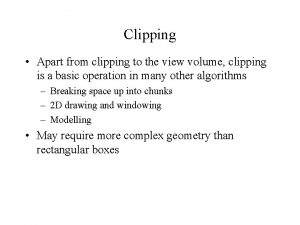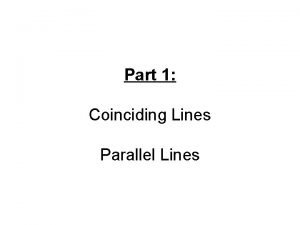Clipping Lines Dr Scott Schaefer Why Clip n





















































![Liang-Barsky Algorithm Initialize interval to [tmin, tmax]=[0, 1] n For each boundary u Find Liang-Barsky Algorithm Initialize interval to [tmin, tmax]=[0, 1] n For each boundary u Find](https://slidetodoc.com/presentation_image_h2/886611ef2eb7d3592fd899a33600b18f/image-54.jpg)








































- Slides: 94

Clipping Lines Dr. Scott Schaefer

Why Clip? n We do not want to waste time drawing objects that are outside of viewing window (or clipping window) 2/94

Clipping Points n Given a point (x, y) and clipping window (xmin, ymin), (xmax, ymax), determine if the point should be drawn (xmax, ymax) (x, y) (xmin, ymin) 3/94

Clipping Points n Given a point (x, y) and clipping window (xmin, ymin), (xmax, ymax), determine if the point should be drawn (xmax, ymax) (x, y) (xmin, ymin) xmin<=x<=xmax? ymin<=y<=ymax? 4/94

Clipping Points n Given a point (x, y) and clipping window (xmin, ymin), (xmax, ymax), determine if the point should be drawn (xmax, ymax) (x 1, y 1) (xmin, ymin) (x 2, y 2) xmin<=x<=xmax? ymin<=y<=ymax? 5/94

Clipping Points n Given a point (x, y) and clipping window (xmin, ymin), (xmax, ymax), determine if the point should be drawn (xmax, ymax) (x 1, y 1) (xmin, ymin) (x 2, y 2) xmin<=x 1<=xmax Yes ymin<=y 1<=ymax Yes 6/94

Clipping Points n Given a point (x, y) and clipping window (xmin, ymin), (xmax, ymax), determine if the point should be drawn (xmax, ymax) (x 1, y 1) (xmin, ymin) (x 2, y 2) xmin<=x 2<=xmax No ymin<=y 2<=ymax Yes 7/94

Clipping Lines 8/94

Clipping Lines 9/94

Clipping Lines n Given a line with end-points (x 0, y 0), (x 1, y 1) and clipping window (xmin, ymin), (xmax, ymax), determine if line should be drawn and clipped end-points of line to draw. (xmax, ymax) (x 1, y 1) (x 0, y 0) (xmin, ymin) 10/94

Clipping Lines 11/94

Clipping Lines – Simple Algorithm If both end-points inside rectangle, draw line n Otherwise, intersect line with all edges of rectangle clip that point and repeat test n 12/94

Clipping Lines – Simple Algorithm 13/94

Clipping Lines – Simple Algorithm 14/94

Clipping Lines – Simple Algorithm 15/94

Clipping Lines – Simple Algorithm 16/94

Clipping Lines – Simple Algorithm 17/94

Clipping Lines – Simple Algorithm 18/94

Clipping Lines – Simple Algorithm 19/94

Clipping Lines – Simple Algorithm 20/94

Clipping Lines – Simple Algorithm 21/94

Clipping Lines – Simple Algorithm 22/94

Clipping Lines – Simple Algorithm 23/94

Window Intersection (x 1, y 1), (x 2, y 2) intersect with vertical edge at xright t yintersect = y 1 + m(xright – x 1) where m=(y 2 -y 1)/(x 2 -x 1) (x 1, y 1), (x 2, y 2) intersect with horizontal edge at ybottom t xintersect = x 1 + (ybottom – y 1)/m where m=(y 2 -y 1)/(x 2 -x 1) 24/94

Clipping Lines – Simple Algorithm Lots of intersection tests makes algorithm expensive n Complicated tests to determine if intersecting rectangle n n Is there a better way? 25/94

Trivial Accepts Big Optimization: trivial accepts/rejects n How can we quickly decide whether line segment is entirely inside window n Answer: test both endpoints n 26/94

Trivial Accepts Big Optimization: trivial accepts/rejects n How can we quickly decide whether line segment is entirely inside window n Answer: test both endpoints n 27/94

Trivial Rejects How can we know a line is outside of the window n Answer: both endpoints on wrong side of same edge, can trivially reject the line n 28/94

Trivial Rejects How can we know a line is outside of the window n Answer: both endpoints on wrong side of same edge, can trivially reject the line n 29/94

Cohen-Sutherland Algorithm Classify p 0, p 1 using region codes c 0, c 1 n If , trivially reject n If , trivially accept n Otherwise reduce to trivial cases by splitting into two segments n 30/94

Cohen-Sutherland Algorithm Every end point is assigned to a four-digit binary value, i. e. Region code n Each bit position indicates whether the point is inside or outside of a specific window edge n bit 4 bit 3 bit 2 bit 1 top bottom right left 31/94

Cohen-Sutherland Algorithm 32/94

Cohen-Sutherland Algorithm Classify p 0, p 1 using region codes c 0, c 1 n If , trivially reject n If , trivially accept n Otherwise reduce to trivial cases by splitting into two segments n 33/94

Cohen-Sutherland Algorithm Classify p 0, p 1 using region codes c 0, c 1 n If , trivially reject n If , trivially accept n Otherwise reduce to trivial cases by splitting into two segments n 34/94

Cohen-Sutherland Algorithm Classify p 0, p 1 using region codes c 0, c 1 n If , trivially reject n If , trivially accept n Otherwise reduce to trivial cases by splitting into two segments n Line is outside the window! reject 35/94

Cohen-Sutherland Algorithm Classify p 0, p 1 using region codes c 0, c 1 n If , trivially reject n If , trivially accept n Otherwise reduce to trivial cases by splitting into two segments n Line is inside the window! draw 36/94

Cohen-Sutherland Algorithm Classify p 0, p 1 using region codes c 0, c 1 n If , trivially reject n If , trivially accept n Otherwise reduce to trivial cases by splitting into two segments n 37/94

Cohen-Sutherland Algorithm 38/94

Cohen-Sutherland Algorithm 39/94

Cohen-Sutherland Algorithm 40/94

Cohen-Sutherland Algorithm 41/94

Cohen-Sutherland Algorithm 42/94

Cohen-Sutherland Algorithm 43/94

Cohen-Sutherland Algorithm 44/94

Cohen-Sutherland Algorithm 45/94

Cohen-Sutherland Algorithm 46/94

Cohen-Sutherland Algorithm 47/94

Cohen-Sutherland Algorithm 48/94

Cohen-Sutherland Algorithm 49/94

Cohen-Sutherland Algorithm 50/94

Cohen-Sutherland Algorithm 51/94

Cohen-Sutherland Algorithm 52/94

Liang-Barsky Algorithm Uses parametric form of line for clipping n Lines are oriented Classify lines as moving inside to out or outside to in n Don’t find actual intersection points Find parameter values on line to draw n 53/94
![LiangBarsky Algorithm Initialize interval to tmin tmax0 1 n For each boundary u Find Liang-Barsky Algorithm Initialize interval to [tmin, tmax]=[0, 1] n For each boundary u Find](https://slidetodoc.com/presentation_image_h2/886611ef2eb7d3592fd899a33600b18f/image-54.jpg)
Liang-Barsky Algorithm Initialize interval to [tmin, tmax]=[0, 1] n For each boundary u Find parametric intersection t with boundary u If moving in to out, tmax = min(tmax, t) u else tmin = max(tmin, t) u If tmin>tmax, reject line n 54/94

Intersecting Two Parametric Lines 55/94

Intersecting Two Parametric Lines 56/94

Intersecting Two Parametric Lines 57/94

Intersecting Two Parametric Lines 58/94

Intersecting Two Parametric Lines 59/94

Intersecting Two Parametric Lines Substitute t or s back into equation to find intersection 60/94

Liang-Barsky: Classifying Lines 61/94

Liang-Barsky: Classifying Lines 62/94

Liang-Barsky: Classifying Lines 63/94

Liang-Barsky: Classifying Lines 64/94

Liang-Barsky: Classifying Lines 65/94

Liang-Barsky: Classifying Lines 66/94

Liang-Barsky: Classifying Lines 67/94

Liang-Barsky: Classifying Lines 68/94

Liang-Barsky Algorithm 69/94

Liang-Barsky Algorithm 70/94

Liang-Barsky Algorithm 71/94

Liang-Barsky Algorithm 72/94

Liang-Barsky Algorithm 73/94

Liang-Barsky Algorithm 74/94

Liang-Barsky Algorithm 75/94

Liang-Barsky Algorithm 76/94

Liang-Barsky Algorithm 77/94

Liang-Barsky Algorithm 78/94

Liang-Barsky Algorithm 79/94

Liang-Barsky Algorithm 80/94

Liang-Barsky Algorithm 81/94

Liang-Barsky Algorithm 82/94

Liang-Barsky Algorithm 83/94

Liang-Barsky Algorithm 84/94

Liang-Barsky Algorithm 85/94

Liang-Barsky Algorithm 86/94

Liang-Barsky Algorithm 87/94

Liang-Barsky Algorithm 88/94

Liang-Barsky Algorithm 89/94

Liang-Barsky Algorithm 90/94

Liang-Barsky Algorithm 91/94

Liang-Barsky Algorithm 92/94

Comparison n Cohen-Sutherland Repeated clipping is expensive u Best used when trivial acceptance and rejection is possible for most lines u n Liang-Barsky Computation of t-intersections is cheap (only one division) u Computation of (x, y) clip points is only done once u Algorithm doesn’t consider trivial accepts/rejects u Best when many lines must be clipped u 93/94

Line Clipping – Considerations Just clipping end-points does not produce the correct results inside the window n Must also update sum in midpoint algorithm n n Clipping against non-rectangular polygons is also possible but seldom used 94/94
 Scott schaefer tamu
Scott schaefer tamu Scott schaefer tamu
Scott schaefer tamu Hey bye bye
Hey bye bye Moos and schaefer 1984 crisis theory
Moos and schaefer 1984 crisis theory Schaefer model
Schaefer model Beistrichsetzung
Beistrichsetzung Ernst schaefer md
Ernst schaefer md Analyse
Analyse Moo
Moo Piero della francesca
Piero della francesca Michael nagel rechtsanwalt
Michael nagel rechtsanwalt Worksheet 1-1 points lines and planes
Worksheet 1-1 points lines and planes Don't ask why why why
Don't ask why why why In two dimensional viewing we have?
In two dimensional viewing we have? Clipping algorithm
Clipping algorithm Who is clipping
Who is clipping Whats a bound morpheme
Whats a bound morpheme Nicholl-lee-nicholl line clipping
Nicholl-lee-nicholl line clipping Back formation examples
Back formation examples Computer graphics chapter 1 ppt
Computer graphics chapter 1 ppt Edge table in computer graphics
Edge table in computer graphics Point clipping in computer graphics
Point clipping in computer graphics Algoritma cohen sutherland
Algoritma cohen sutherland Cliping adalah
Cliping adalah Ywmin
Ywmin Recap intensity clipping
Recap intensity clipping Bezier clipping
Bezier clipping Westlaw video clipping
Westlaw video clipping Hidden surface removal
Hidden surface removal Flood fill algorithm in computer graphics
Flood fill algorithm in computer graphics Blackout compounding or blending
Blackout compounding or blending Viewport clipping in computer graphics
Viewport clipping in computer graphics Ear clipping algorithm
Ear clipping algorithm 4 types of clipping
4 types of clipping Vertical edge
Vertical edge Line clipping
Line clipping نردشير meaning in english
نردشير meaning in english Cohen sutherland line clipping algorithm solved example
Cohen sutherland line clipping algorithm solved example Text clipping in computer graphics
Text clipping in computer graphics Word formation process coinage
Word formation process coinage English clipped words
English clipped words Steer clipping and fitting techniques
Steer clipping and fitting techniques Clipping
Clipping Clipping and culling
Clipping and culling Curve clipping in computer graphics
Curve clipping in computer graphics Disadvantages of suspension therapy in physiotherapy
Disadvantages of suspension therapy in physiotherapy Ocular adjustment function
Ocular adjustment function Boston resolution clip
Boston resolution clip Clip clop don't stop
Clip clop don't stop Atri clip
Atri clip Atrial clip procedure
Atrial clip procedure Mathswatch clip 150 answers
Mathswatch clip 150 answers A pistol with a clip fed mechanism
A pistol with a clip fed mechanism Evaluation clip art
Evaluation clip art Watch the video and answer the question.
Watch the video and answer the question. Date
Date Reiteration method in theodolite surveying
Reiteration method in theodolite surveying Old crime scene
Old crime scene Weight of paperclip
Weight of paperclip Luke 6 27 38
Luke 6 27 38 Cara menyisipkan clip art
Cara menyisipkan clip art Cinema clip art
Cinema clip art Premiere android
Premiere android Shrek vimeo
Shrek vimeo Ioki clip
Ioki clip What animal is at the top of the food chain
What animal is at the top of the food chain Find the area of the shape below mathswatch
Find the area of the shape below mathswatch Jessica ve muhammed
Jessica ve muhammed On which playing card is the cardmaker's trademark
On which playing card is the cardmaker's trademark Fipa clip
Fipa clip Clip art microsoft word 2013
Clip art microsoft word 2013 Judicial branch clip art
Judicial branch clip art Introductions clip art
Introductions clip art Rt6939 datasheet
Rt6939 datasheet Extinction clip art
Extinction clip art Chanson gobelet clip
Chanson gobelet clip Vido clip
Vido clip Class 5 avalanche
Class 5 avalanche Rule the waves
Rule the waves Rotc timeline
Rotc timeline Braylin
Braylin Watch the video and answer the questions
Watch the video and answer the questions Thai singer clip
Thai singer clip The paperclip challenge
The paperclip challenge Microsoft exchange onpremises mitigation
Microsoft exchange onpremises mitigation Mark 3: 20-35
Mark 3: 20-35 Ionizing radiation
Ionizing radiation Dini clip
Dini clip Gigaset quicksync mac download
Gigaset quicksync mac download Credits clip art
Credits clip art Renaldo and nasreen build an electromagnet
Renaldo and nasreen build an electromagnet Westward expansion clip art
Westward expansion clip art Lesson plan clip art
Lesson plan clip art Efmd clip
Efmd clip Clip art word
Clip art word

